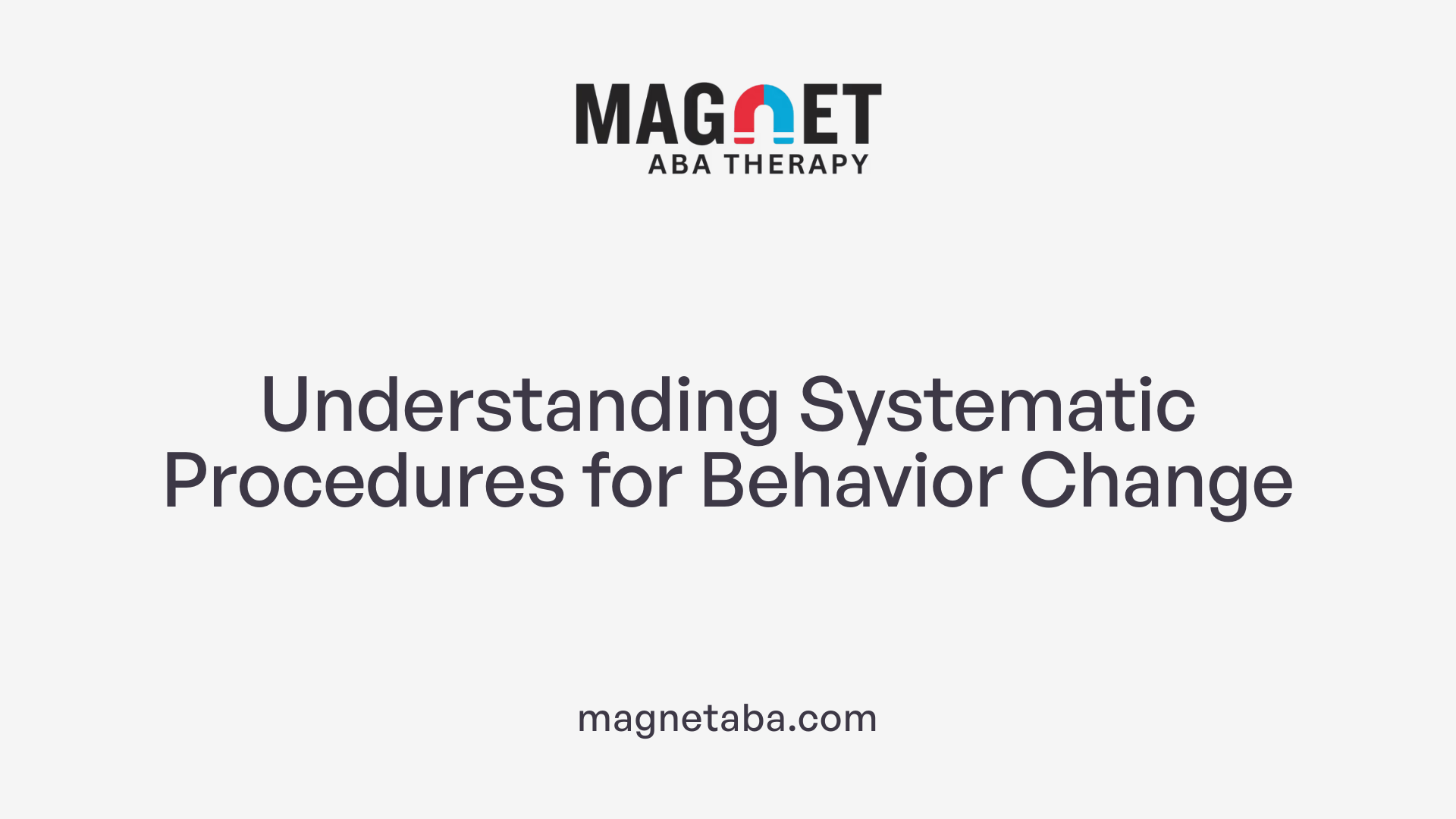Understanding the Foundations of Gradual Demand Increase
Effectively increasing task demands in therapy requires a nuanced approach rooted in principles of behavior analysis, developmental appropriateness, and individualized client needs. This article explores systematic procedures, behavioral techniques, environmental modifications, and practical strategies to facilitate steady progress while minimizing stress and resistance.
Core Principles of Gradual Change Procedures
Gradual change procedures in behavior analysis include strategies such as shaping, thinning, fading, and chaining. These methods are designed to modify behavior systematically by slowly adjusting various aspects of the behavioral contingency.
These procedures involve intentional, step-by-step adjustments to stimuli, response requirements, reinforcement schedules, or multiple facets of the contingency. By making incremental changes, learners are supported in progressing towards desired behaviors without becoming overwhelmed.
For example, stimulus fading involves gradually changing the sensory characteristics of a stimulus—such as color or size—to help the learner adapt. Response requirement changes include increasing the number of responses needed before reinforcement, employing chaining to connect multiple steps, and demand fading by gradually lowering task difficulty. Reinforcement adjustments often involve reducing the overall reinforcement rate or increasing delays, a process known as schedule thinning.
A taxonomy categorizes these procedures into three broad types based on the aspect of the contingency they target:Changes in discriminative stimuli, Response requirements, and Reinforcement. This classification helps clarify the overlapping and sometimes ambiguous terminology present in the literature.
One common procedure is shaping, which involves reinforcing successive approximations towards a target behavior. Rather than waiting for a learner to perform a complex skill all at once, shaping breaks the skill down into smaller, manageable steps, reinforcing each one as it is achieved. This approach promotes learning through differential reinforcement and reduces the likelihood of overwhelm.
Demand fading is an example where instructions or tasks are systematically removed and reintroduced gradually. This method can lead to immediate reductions in challenging behaviors and supports maintenance of gains when demands are later reintroduced.
Fading, originally used specifically for discriminative stimuli, now broadly refers to any systematic reduction in prompting, cueing, or support. Combining fading with other gradual change procedures enhances flexibility and effectiveness.
Overall, these strategies emphasize understanding the functional component of the behavior change, ensuring that modifications are purposeful and tailored to individual needs. This understanding helps avoid reliance on rote procedures, instead focusing on the environmental or contextual factors that influence behavior.
The complexity of terminology and overlap among procedures makes categorization important. Clear definitions and structured approaches facilitate consistent application and maximize treatment outcomes.
Whether through shaping, fading, chaining, or schedule thinning, gradual change procedures provide a thoughtful, stepwise approach to learning new behaviors and reducing problematic ones, by supporting learners through incremental progress and reinforcement.
Categories of Gradual Change in Therapy

What are common methods for managing demand avoidance behaviors?
Managing demand avoidance behaviors involves a variety of strategies aimed at reducing anxiety and increasing cooperation. Building trust and rapport with the individual is essential, often achieved by using indirect language and avoiding demand words to minimize perceived pressure.
One effective approach is offering choices, which provides the individual with a sense of control, making them more receptive. Short breaks are also incorporated into routines to prevent overwhelm and allow emotional regulation.
Creating a predictable routine helps establish a sense of safety and familiarity, reducing the likelihood of resistance. Sensory regulation activities and sensory-friendly environments can address physical discomforts that may trigger avoidance.
Rephrasing demands into more acceptable terms, including humor, can make expectations less intimidating. Visual prompts, social stories, and other supports aid understanding and reduce anxiety.
It's crucial for caregivers and therapists to remain calm, flexible, and empathetic, tailoring interventions to the individual's unique needs. Avoiding confrontational or high-pressure tactics fosters a supportive atmosphere that encourages engagement.
How do gradual change procedures fit into behavior therapy?
Gradual change procedures are fundamental in behavior analysis, allowing modifications in stimuli, response requirements, or reinforcement patterns over time. This approach ensures the individual is not overwhelmed and can learn new behaviors in manageable steps.
These procedures can be categorized into three broad areas:
- Changes in discriminative stimuli involve systematic alterations such as stimulus fading, where one stimulus gradually transforms into another. For example, changing the color of a visual cue to make it less salient.
- Response requirement modifications include increasing responses incrementally, chaining behaviors, or demand fading—reducing task demands gradually.
- Reinforcement adjustments often mean schedule thinning, where the frequency or magnitude of reinforcement is decreased while maintaining motivation.
What are examples of gradual change procedures?
Examples encompass stimulus fading, prompt fading, demand fading, schedule thinning, chaining, shaping, delay fading, and schedule thinning.
Stimulus fading might involve slowly changing the color or brightness of visual cues. Prompt fading reduces assistance as learners become more independent. Demand fading gradually lowers the difficulty level of tasks, while schedule thinning decreases reinforcement density over time. Chaining links smaller behaviors into a complex sequence, gradually building toward the full skill. Shaping involves reinforcing successive approximations of a target behavior, starting from simple actions. Delay fading introduces delays in reinforcement, testing whether the learner maintains motivation.
How does the framework clarify different approaches?
The framework emphasizes understanding which component—stimulus, response, or reinforcement—is changing and how these influence behavior. It aims to clarify the sometimes complex and overlapping terminology in the literature by categorizing procedures distinctly.
This clarity aids practitioners in designing effective interventions tailored to individual progress, ensuring that each change is functionally appropriate and systematically implemented.
How is shaping used to develop behaviors?
Shaping is a process where small, achievable steps are reinforced, gradually approximating the target behavior. This is especially useful in complex skills like verbal communication, daily living activities, or health behaviors.
For example, in teaching verbal requests, any vocalization might initially be reinforced, with reinforcement gradually contingent upon more specific verbalizations.
In daily skills, reinforcing small actions such as acknowledging a table or standing near it builds toward the complete task.
Shaping helps prevent overwhelming the learner, creating continuous opportunities for success that motivate ongoing learning.
What about adapting procedures to individual needs?
Flexibility is essential, as progress is not always linear. Adjustments to steps and reinforcement strategies may be necessary based on individual responses.
Proactive strategies like priming, 'First, Then' sequences, and providing choices can support engagement and reduce resistance.
Visual supports and structured routines also facilitate learning by making expectations clear and predictable.
How do these approaches contribute to effective therapy?
Together, gradual change procedures and supportive strategies build a structured yet adaptable framework. This approach respects individual differences, promotes functional skills, and fosters motivation and confidence.
By systematically manipulating stimuli, responses, and reinforcements, therapists help clients learn new behaviors without causing unnecessary stress or frustration, ensuring sustainable progress in therapy.
Implementing Fading Techniques to Reduce Overwhelm
Fading is a widely used method in behavior analysis that originally referred to gradually changing discriminative stimuli, such as transforming one stimulus into another, to support learning. Over time, the concept of fading has expanded to include any process of slowly modifying stimuli or contingencies, such as response requirements or reinforcement schedules, to help learners adapt and progress.
One specific approach, demand fading, involves starting with simpler tasks or instructions and gradually increasing their complexity or difficulty. This allows the learner to build confidence and mastery without becoming overwhelmed, which is especially important for individuals who exhibit avoidance or anxiety towards demanding tasks.
Stimulus fading and prompt fading are also common strategies utilized within the fading framework. These techniques systematically reduce cues or prompts that facilitate learning, with the goal of fostering independence. For instance, prompts can be layered from most supportive to least, gradually withdrawing each prompt to encourage autonomous responses.
What is demand fading in therapy?
Demand fading consists of the removal and gradual reintroduction of instructions or tasks. It is often used to decrease problematic behaviors that occur when demands are presented abruptly or at too high a level for the learner. The process involves initially presenting manageable demands that the individual can complete successfully, then slowly increasing the challenge as their skills improve.
This method has shown to result in immediate reductions of challenging behaviors often associated with demand presentation. Additionally, demand fading maintains treatment gains by reinforcing positive responses at each step of increase, ensuring the learner remains successful and engaged.
In practice, demand fading might look like asking a learner to perform a simple task, such as touching a card, then gradually requiring more complex actions, like completing a sequence or following multi-step instructions.
Strategies for effective fading
Implementing fading requires careful planning and monitoring. Some strategies include:
- Starting with tasks below the learner’s current skill level.
- Using visual aids or timers to signal changes in demands.
- Gradually increasing the difficulty or number of responses.
- Combining fading with reinforcement to encourage desired behaviors.
- Adjusting the pace of fading based on the individual’s responsiveness.
For more detailed methods, exploring "Demand fading techniques and strategies" can provide additional insights into customizing these approaches for specific learners and contexts.
Shaping and Prompt Fading to Build Skills and Engagement

How can behavior shaping and prompt fading be used to increase task engagement?
Behavior shaping and prompt fading are powerful techniques used in behavior analysis to improve how individuals engage with tasks, especially when working towards learning new skills or promoting independence.
Shaping involves reinforcing successive, small steps that gradually lead to the target behavior. For instance, if a child is learning to say a new word, the therapist might reinforce any vocalization initially, then only praise multiple sounds, and finally, the full word. This incremental reinforcement helps build complex behaviors in manageable pieces.
Prompt fading involves systematically reducing the level of assistance provided during an activity. For example, a teacher may start with physical guidance to help a student write, then move to gestural prompts, and eventually rely solely on natural cues. This gradual removal of prompts encourages the learner to perform tasks independently.
Both methods use incremental adjustments—either in response requirements or prompting levels—to avoid overwhelming the learner. These adjustments create a supportive learning environment where progress is steady and attainable, reducing frustration or dependency on prompts.
When combined with reinforcement, these procedures motivate learners by highlighting small successes, which can lead to longer and more consistent engagement. Over time, individuals become more autonomous and confident in their abilities, making these techniques essential in educational and therapeutic settings.
Tailoring Interventions to Developmental Levels
How can interventions be tailored to individual developmental levels to support progress?
Effective interventions are personalized, taking into account each child's unique developmental stage. This personalization begins with comprehensive assessments that evaluate cognitive, emotional, social, and behavioral capacities. By understanding a child's strengths and challenges, practitioners can design strategies that are appropriately challenging yet achievable.
Developmentally suitable activities are crucial for keeping children engaged and motivated. For instance, younger children may benefit from play-based and visual activities, whereas older children might engage more with task-based and self-directed approaches. Ensuring activities match the child's cognitive ability prevents frustration, promotes confidence, and encourages steady progress.
Engaging families as active partners in intervention planning and execution enhances consistency and generalization of skills across settings. Cultural relevance is equally important; interventions should respect and incorporate the child's cultural and linguistic background, making learning meaningful and sustainable for the family.
Ongoing assessment plays a vital role in adapting interventions as the child's needs evolve. Regular reviews help identify areas of progress or stagnation, allowing practitioners to modify strategies promptly. This dynamic process ensures that support remains aligned with the child's developmental trajectory, promoting continued growth and skill acquisition.
Systematic Approaches and Practical Resources for Demand Escalation
What practical steps and resources are available for implementing demand escalation in therapy?
Implementing demand escalation effectively relies on a combination of evidence-based strategies rooted in behavior analysis. Techniques such as demand fading, shaping, and systematic reinforcement are integral components supported by extensive professional literature. Demand fading involves gradually increasing the complexity or intensity of tasks, enabling clients to build tolerance in a controlled manner.
Shaping involves reinforcing successive approximations toward the desired behavior, making it easier for clients to adapt to increasing demands without becoming overwhelmed. Reinforcement procedures, including delay fading and schedule thinning, help manage the rate and intensity of demand escalation.
Environmental modifications play a vital role. Adjustments like creating calm, predictable settings, and reducing potential triggers can minimize resistance. Staff training is equally important; practitioners should develop skills in de-escalation techniques, recognition of early agitation signs, and respectful communication. These skills can be cultivated through dedicated training programs.
Resources such as role-playing, simulation exercises, and ongoing education programs are essential. For example, organizations like Pollack Peacebuilding Systems offer structured courses, workshops, and online modules that enhance staff readiness to handle challenging situations.
Addressing resistance requires strategies such as open-ended questioning to understand client perspectives and collaborative goal setting to foster cooperation. Empathy and a solution-focused approach help build trust and reduce triggers that might lead to escalation.
Support tools like flexible escalation protocols and systematic information management further aid clinicians. These protocols provide clear guidelines during crises, while enhanced information systems support swift decision-making. Overall, combining these systematic techniques with resource-rich training environments creates a foundation for safe, effective demand escalation in therapeutic contexts.
Behavior Analysis Framework and Functional Components of Change

Understanding the functional components of change involves analyzing what aspects of contingencies influence behavior.
In behavior analysis, changing behavior systematically requires a clear understanding of how stimuli, responses, and reinforcement interact. The procedures aim to modify these elements gradually, ensuring stable and lasting behavioral changes.
Taxonomies categorize systematic procedures based on changes to stimuli, responses, and reinforcement.
A structured classification helps practitioners select appropriate tools for target behaviors. For example, changes in discriminative stimuli include stimulus fading, where one stimulus is gradually transformed into another (e.g., changing a key color). Response modifications involve increasing response requirements through methods like chaining or shaping. Reinforcement adjustments include schedule thinning, which decreases reinforcement rate gradually to promote independence.
This framework helps in designing targeted interventions that gradually increase demands while ensuring behavior stability.
Gradual procedures like fading, shaping, and chaining allow learners to adapt steadily. These approaches focus on making incremental adjustments to stimuli, response effort, or reinforcement schedules. Understanding the functional component behind each change helps ensure interventions reinforce desired behaviors effectively and promote generalization.
What is demand fading in therapy?
Demand fading involves the systematic removal and gradual reintroduction of instructions or demands. Initially, demands are minimized or simplified to reduce unmanageable behavior or anxiety. Over time, the demands are gradually increased as the learner demonstrates competence at each step. This process often leads to a quick reduction in challenging behaviors and supports maintaining treatment gains when demands are reintroduced at appropriate levels.
The overall goal of these methods is to scaffold behavior change, making sure that the individual can handle increasing complexity or effort without becoming overwhelmed or regressing. The use of a well-structured taxonomy helps practitioners target specific aspects of behavior and adjust contingencies in a precise, functional manner.
Supporting Cognitive and Behavioral Progress through Demand Modulation
Demand modulation is a strategic approach used in behavior analysis and occupational therapy to facilitate cognitive functions such as memory, attention, and problem-solving. The process involves carefully adjusting the demands placed on clients—whether through task complexity, reinforcement schedules, or support levels—to promote gradual mastery of skills.
Progress in cognitive and behavioral goals depends on a precise calibration of changes. This means increasing the difficulty of tasks, the response requirements, or the expectations gradually as the individual shows readiness. For example, breaking a large, overwhelming task into smaller, more manageable steps helps prevent frustration and foster a sense of achievement.
A common technique is starting with simple activities and gradually raising the challenge level. For instance, initial tasks might involve simple memory games or focused attention exercises, which then evolve into more complex problem-solving or multi-step tasks.
Supporting strategies include the use of visual supports like checklists or schedules to provide clarity and predictability. Reinforcement plays a critical role—providing positive feedback and tangible rewards after successful completion of each step encourages continued engagement and learning.
Reinforcement schedules, including schedule thinning, are adjusted to slowly reduce dependency on external reinforcement, fostering intrinsic motivation over time. Consistent routines and positive environmental cues also help create a safe learning space, making the gradual increase in demands more natural.
To ensure steady progress, ongoing assessment and adaptive adjustments are necessary. Therapists and caregivers should observe responses closely and modify strategies accordingly, always aligning interventions with the individual’s developmental level and capacity.
By incrementally increasing challenge, breaking down complex tasks, and reinforcing success, demand modulation supports sustained cognitive and behavioral growth. This method helps clients build confidence and competence, paving the way for greater independence and functional skill mastery.
| Technique | Application | Purpose |
|---|---|---|
| Task Breakdown | Dividing activities into smaller parts | Prevent overwhelm, facilitate stepwise skill acquisition |
| Gradual Challenge Increase | Slowly raising task difficulty or duration | Promote learning without causing frustration |
| Visual Supports | Using checklists, schedules, or pictorial cues | Improve clarity and predictability for learners |
| Positive Reinforcement | Offering rewards for successful task completion | Motivate and encourage continued effort |
| Routine Development | Implementing consistent schedules and cues | Reduce anxiety, enhance readiness for demands |
Integrating Evidence-Based Practices and Ensuring Effectiveness
Effective behavior management relies on systematic, evidence-based strategies that adapt seamlessly to clients' evolving needs. Best practices for progressing in therapy include continuous monitoring of client responses alongside the flexibility to adjust procedures as necessary. Using structured routines, visual schedules, and reinforcement not only stabilizes the learning environment but also facilitates the safe increase of demands. These tools help clients anticipate upcoming activities, reduce anxiety, and foster motivation, making the escalation process smoother.
Profound professional development and ongoing training are essential for practitioners to stay current with scientifically supported methods. Training programs should emphasize the practical application of procedures such as demand fading, shaping, and reinforcement schedules, ensuring clinicians are proficient in implementing these strategies effectively.
What practical steps and resources are available for implementing demand escalation in therapy?
To effectively implement demand escalation, practitioners should utilize a combination of evidence-based techniques such as demand fading, chaining, and reinforcement systems. These methods can be supported by established guidelines from behavior analysis literature to promote gradual increases in task difficulty.
Training programs and resources, like those offered by organizations such as Pollack Peacebuilding Systems, provide valuable tools including role-playing, simulation exercises, and ongoing education to enhance staff skills in de-escalation and resistance management.
Addressing potential client resistance involves techniques like open-ended questioning, expressing empathy, and engaging in collaborative goal-setting. These approaches help foster cooperation and reduce triggers for escalation.
Supporting clinicians' decision-making is crucial, so establishing flexible protocols for escalation and utilizing robust information systems can assist in making well-informed judgments during challenging situations.
Resources for implementing demand escalation in therapy
| Resource Type | Examples | Purpose |
|---|---|---|
| Training Programs | Pollack Peacebuilding Systems, ABAI workshops | Skill development in behavior management and de-escalation |
| Protocols and Guidelines | Behavior analysis literature, clinical manuals | Frameworks for systematic demand escalation |
| Tools and Strategies | Visual schedules, reinforcement charts, social stories | Facilitation of structured routines and client cooperation |
| Support Networks | Supervision, peer consultation, online forums | Continuous learning and problem-solving |
By integrating these resources with ongoing professional development, practitioners can confidently manage demand escalation while ensuring client safety and progress.
Practical Strategies to Support Task Progression
 Gradual increase of task demands is a cornerstone approach in behavior analysis and occupational therapy. It involves carefully structured routines, visual supports, and behavioral techniques to help clients adapt smoothly to higher levels of challenge.
Gradual increase of task demands is a cornerstone approach in behavior analysis and occupational therapy. It involves carefully structured routines, visual supports, and behavioral techniques to help clients adapt smoothly to higher levels of challenge.
One effective way to facilitate progression is through the use of visual supports such as checklists, schedules, and visual cues. These tools help clients understand what to expect, reduce uncertainty, and create a sense of predictability. Structured routines also provide a stable environment, which minimizes anxiety and encourages consistency.
In addition, breaking down complex tasks into smaller, manageable steps can prevent overwhelm. For example, teaching a client to make a phone call can begin with assembling the necessary items, then progressing to dialing, and finally to speaking on the phone. Reinforcing each small success fosters confidence and motivation.
Providing choices during task engagement is another powerful strategy. Allowing individuals to select the order of tasks, the type of materials, or the preferred reward increases a sense of control. This autonomy not only boosts motivation but also supports independence.
Behavioral techniques such as reinforcement are essential. Offering rewards or breaks contingent on task completion encourages continued effort and helps establish positive associations with challenging activities.
Managing stress and anxiety linked to increasing demands is equally important. Incorporating mindfulness, relaxation, and desensitization techniques can significantly reduce apprehension. Deep breathing exercises, progressive muscle relaxation, and mindfulness meditation are commonly used tools.
Desensitization involves gradual exposure to feared or avoided tasks, with repeated, controlled challenges that build confidence over time. This process, combined with scaffolding and support, helps clients tolerate and adapt to higher demands.
Creating a supportive environment is vital. Providing reassurance, fostering a growth mindset, and offering emotional support can reduce stress and promote resilience. Therapists and caregivers should work collaboratively with clients, acknowledging their efforts and celebrating progress.
Overall, supporting stress management during demand escalation is a dynamic process. It requires patience, flexibility, and a tailored approach that respects individual needs and paces.
Additional Strategies for Managing Task Avoidance and Stress
Addressing avoidance behaviors and reducing stress can be accomplished through several techniques:
- Breaking tasks into smaller, achievable steps
- Implementing predictable routines and visual supports
- Offering choices to increase engagement
- Using mindfulness and relaxation strategies like deep breathing
- Employing desensitization through gradual exposure
- Creating a positive, supportive environment that encourages effort
These combined strategies help individuals develop resilience, confidence, and independence, enabling them to meet increased demands successfully.
Real-Life Examples of Gradual Task Demands and Activity Modification
 Gradual change procedures are essential in therapy and skill development, as they ensure tasks are manageable and tailored to an individual’s evolving abilities. One common approach involves grading activities, which is the process of systematically increasing or decreasing task complexity to support progress.
Gradual change procedures are essential in therapy and skill development, as they ensure tasks are manageable and tailored to an individual’s evolving abilities. One common approach involves grading activities, which is the process of systematically increasing or decreasing task complexity to support progress.
Activities like making a phone call offer clear examples of how grading can be implemented. Initially, a person might start by gathering necessary materials, such as a phone book or contact list. Once comfortable, they can move on to assembling the items or practicing the sequence of steps involved. Over time, the task can include managing time expectations, practicing in quiet settings, and eventually making spontaneous, independent calls without prompts.
Both occupational therapy and cardiac rehabilitation routinely employ grading techniques to match activities with a client's current capacity. For example, an occupational therapist might break down daily routines into smaller, more manageable steps, gradually increasing the challenge as the client improves. Similarly, in cardiac rehab, exercises progress from passive movements to active, independent tasks that boost endurance and functional capacity.
The overarching goal of grading is to enhance a person’s confidence and independence by helping them succeed at each step before advancing to more demanding activities. Adjustments are made based on ongoing assessments, ensuring that each activity aligns with the individual's skill level.
How can activities be graded to support gradual increase in demand?
Activities are structured by breaking down complex actions into smaller, easier components. This includes adjusting physical demands, like reducing weight or resistance, and cognitive requirements, such as simplifying instructions or reducing response times.
For instance, in teaching someone to make a phone call, the process begins with simple tasks like gathering the phone and contact information. Once mastered, the activity might involve assembling the call, practicing greetings, and then progressing to real calls. The performance expectations gradually increase, fostering skills with manageable challenges.
In treatment settings, this approach has shown tangible results. Clients demonstrate steady gains in independence and confidence, making gradual activity modifications highly effective. Documentation of progress highlights improvements, such as longer task durations, increased accuracy, and spontaneous task initiation. Overall, grading helps clients build skills incrementally, paving the way for greater independence in everyday activities.
The Art of Incremental Progress in Therapy
Successfully increasing task demands requires a strategic blend of behavioral techniques, developmental sensitivity, and environmental supports. Employing systematic procedures like demand fading, shaping, and stimulus fading, alongside individualized adaptations and environmental modifications, ensures safe, effective, and sustainable growth. Continuous assessment, professional development, and client-centered approaches are vital for fostering confidence, independence, and resilient progress. By thoughtfully applying these principles, therapists can guide clients through incremental challenges toward greater competence and autonomy.
References
- Gradual Change Procedures in Behavior Analysis - PMC
- Behavior Shaping & Gradual Steps Toward Positive Change
- How to Improve On Task Behavior in ABA Therapy - Ujala Life
- Understanding Demand Avoidance in ADHD and Effective ...
- [PDF] Activity Gradation and Adaptation
- Cognitive Remediation Therapy: 13 Exercises & Worksheets
- Stuck at the Start: Tips for ADHD and Task Initiation











